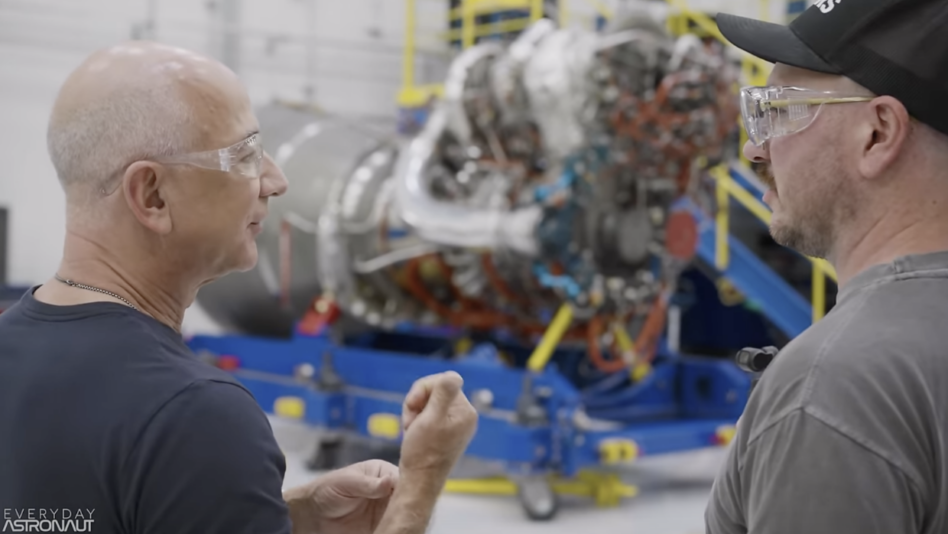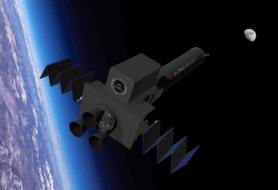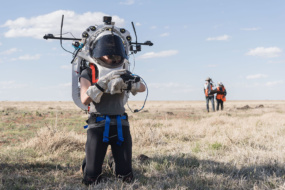After years of largely building in stealth, Jeff Bezos is finally opening up about Blue Origin’s soon-to-be-launched mega New Glenn rocket.
In what has become a rite of passage for rocket startups, Bezos invited Tim Dodd—better known as the Everyday Astronaut—on a video walkthrough of the Florida New Glenn facility. On the tour, Bezos unveiled new insights on second-stage reusability, manufacturing, and the future of the 45-ton-to-LEO rocket.
I will pause to highly recommend watching both part one and part two of the Everyday Astronaut videos.
It was a Willy Wonka-style event—a wealthy entrepreneur finally opening the doors to his secretive facility filled with innovative gadgets at a scale beyond imagination. However, instead of chocolate rivers, fizzy-lifting drinks, and Everlasting Gobstoppers, we were treated to fuel lines, heavy-lifting rockets, and boosters designed to last 25 launches.
This time, for sure: The grand introduction comes as New Glenn rapidly approaches its first launch…right?
- Blue Origin announced last week that it had pushed the rocket’s maiden launch back a month to November.
- NASA’s Mars-bound EscaPADE spacecraft was expected to be on board, but Blue’s Blue Ring space tug hardware will catch a ride to space instead.
- The company made the decision in tandem with NASA over concerns about New Glenn’s ability to be ready in time to hit October’s tight Mars transfer window.
Cue Blue Origin is delayed again jokes. While the point is half-warranted, as Blue Origin previously claimed the rocket would fly in 2020, 2021, 2022, 2023, 2024, this time, the company is very, very close to its first liftoff.
Bezos is all in on Blue Origin
After stepping down as CEO of Amazon in 2021, Jeff Bezos moved to Florida to go all in on two things: a 7-day-a-week weightlifting routine and Blue Origin.
“The primary reason that I left my CEO role at Amazon is so I could focus on Blue,” Bezos told Dodd during the facility walkthrough. “Blue is really where I’m putting the vast majority of my productive efforts. And I’m working harder than I ever have.”
Vibe shift: In addition to refocusing his efforts, Bezos brought in Amazon veteran Dave Limp last year to take over as CEO and help shift its reputation from a slow-moving forever R&D company to becoming the “world’s most decisive company.” According to two industry sources, Limp’s stint thus far has been overwhelmingly positive.
Limp oversees a workforce that has ballooned to ~11,000 people, near SpaceX’s ~14,000 employees. If we assume an average salary/benefits cost of $200,000 annually, Blue’s payroll would come in at north of $2B a year.
A large chunk of that employee base is working at the state-of-the-art facility in Florida working on New Glenn, where Bezos told Dodd that the company has four boosters in production.
- The booster generates nearly 4M lbs of thrust, similar power to Falcon Heavy’s 5M lbs of thrust, but less than Starship’s Super Heavy booster at almost 17M lbs of thrust.
- Blue plans to produce multiple boosters per year as it aims for a 12-flight annual cadence.
“We’re going to keep producing GS1s [boosters],” Bezos said. “[For] rate manufacturing, you have to have a rate. You can’t just say you’re going to produce a certain number and then stop.”
However, as the New Glenn flight cadence grows, the company’s first stage reusability plans should allow it to keep booster production relatively low—similar to what SpaceX has done with Falcon 9 first stage builds.
Bezos also provided an update on a couple of the key engine performance and production metrics:
- The BE-4 first stage engines have a specific impulse of 340 s
- Next year, the company said it will build a BE-4 engine every three days.
- In addition to New Glenn, the BE-4 engines also power the ULA Vulcan rocket. Bezos said two complete sets sit with ULA and a third set is about ready to ship.
Partial reusability or full reusability?
Booster reusability: New Glenn is designed to be partially—and potentially fully—reusable. Bezos told Dodd that the New Glenn booster can be reused 25 times, with the hope of eventually getting to 100 missions.
After years of learning how to land New Shepard boosters after suborbital flights, the company believes it will soon be ready to enter the big leagues—landing a booster returning from an orbital mission.
Compared to New Shepard, Bezos said the size of New Glenn is actually an advantage for landing. “Vertical landing likes big rockets because it’s easier to balance a broomstick on the tip of your finger. Try doing that with a pencil.”
New Glenn is designed with a reusable thermal protection system that will enable it to operate with minimal refurb and inspection after deach flight. The company aims to get the vehicle turnaround time between flights down to 16 days.
Full reusability: Out of all of Blue Origin’s programs, reusable second stage Project Jarvis is the most hush-hush.
- Bezos told Dodd they have a design for its second stage vehicle, and they are currently developing the all-important thermal protection system.
- However, the company is still deciding whether they will use aluminum or stainless steel. Stainless steel is heavier but has higher thermal properties, which could make it a better choice.
While Bezos said Project Jarvis is in full swing, he was non-committal about the vehicle—even hinting at potentially shelving second stage vehicle reusability plans if the team concludes an expendable vehicle makes more economic sense.
“When you do that trade on paper, it just isn’t obvious,” he said.
But paper engineering can only tell the team so much, so the company set up a horse race between a reusable or expendable second stage.
“The goal for the expandable stage is to become so cheap to manufacture that reusability never makes sense. The goal for the reusability stage is to become so operable that expendability never makes sense,” Bezos said.
Setting up space infrastructure
Blue Origin built a massive New Glenn pad at Launch Complex 36 at Cape Canaveral and the company is planning to build a second one for redundancy and cadence.
In addition to New Glenn, Blue Origin is working on numerous other infrastructure projects:
- Lunar lander (Blue Moon)
- Space station (Orbital Reef)
- Space tug (Blue Ring)
- Engine supplier (BE-4 / BE-7)
- Crewed spacecraft
Bezos said his goal for all this work is to set up the infrastructure of space to create a similar entrepreneurial environment to the one he was able to take advantage of in the early 2000s with Amazon.
“Space travel is a solved problem,” Bezos said. “It’s been solved for 50 years. What’s unsolved is the cost. We know how to travel to space. We know how to land on the Moon. We need to be able to do it a hundred times cheaper. So that’s what will really open the heavens to humanity. And that’s what will really make it possible for there to be the kind of entrepreneurial dynamism in space that I just got to witness up close and personal over the last 20 years.”
Near the end of the tour, Dodd asked Bezos if New Glenn would ever fly humans. Bezos answered, saying, “Yes, at some point…but that’s still a few years out.”




